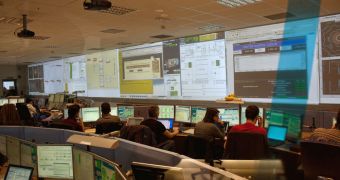By the end of this summer, the Large Hadron Collider (LHC), the most advanced and massive particle accelerator in the world, could become able to search for new elementary particles. The search will take place in an energy domain range that has never been explored before. The LHC is the holder of the world's record for the most energetic collisions ever achieved between two particle beams, and it is the only machine on Earth capable of beating this achievement. No other instrument has the capacity of the 27-kilometer-diameter accelerator. Leading physicists for the project say that the search for the Higgs boson, as well as for the W' and Z' bosons, could begin very soon, the BBC News reports.
The machine is currently in its commissioning phase, which deals with preparing it for operating at such large energy levels. Located under the French-Swiss border, the particle accelerator took more than $10 billion to build, and is widely considered to be the most complex and advanced scientific experiment in the world. It is operated by the European Organization for Nuclear Research (CERN), whose objective is to use the energetic proton beams the LHC accelerates to discover more details about the earliest moments of the Universe, right after the Big Bang took place.
One of the primary targets of studies conducted at the Collider is the discovery of the Higgs boson, a hypothesized elementary particle that would complete the Standard Model nicely. Physicists say that this is the element that allows energy to acquire mass, but thus far efforts to identify it at lower energy levels have failed. Unlike other accelerators, which can barely reach around 1 teraelectronvolts (TeV) of combined beam energy, the LHC can go as high as 14 TeV, making it the ideal tool for such research.
The massive piece of equipment, and all of its detectors, are currently being prepared to start operating in the 1,000 GeV scale. The goal is to find the W' and Z' bosons, which are heavier versions of the W and Z bosons, respectively. These particles underlie the weak nuclear force, one of the four main forces in the Universe, alongside electromagnetism, gravity and the strong nuclear force. CERN discovered the initial W and Z bosons some 30 years ago, while operating an accelerator in the 100 GeV energy domain.

 14 DAY TRIAL //
14 DAY TRIAL //